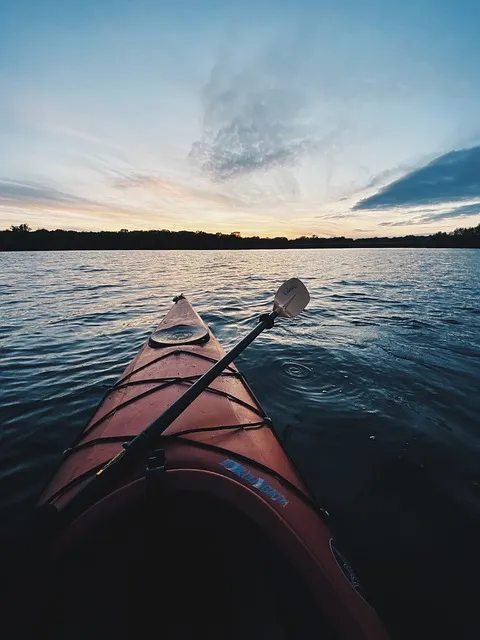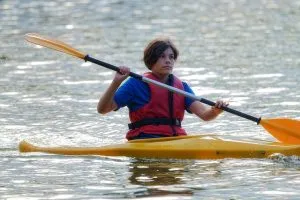Fishing kayaks are specialized vessels designed for stability, maneuverability, and efficient storage, catering to anglers' unique needs. Key features include a balanced hull shape, weight distribution, and control mechanisms like skegs for stability at speed. Modern materials like fiberglass and carbon fiber enhance durability and precision control. Wider beams and flat bottoms improve stability while narrower designs enable tighter turns. Fin design impacts maneuverability, with broader fins offering stability and narrower ones allowing sharper turns. Rigorous testing is crucial to refine the kayak's performance across diverse water conditions, making fishing kayaks a game-changer for anglers worldwide.
“Unleash your inner angler with the perfect fishing kayak—a stable, maneuverable vessel that enhances your casting accuracy and overall fishing experience. This comprehensive guide explores the critical design elements that ensure a kayak’s stability, from understanding the unique demands of fishing to material choices and fin design. Discover how easy-to-control maneuverability translates into increased success on the water. Dive into this article to learn from real-world applications and transform your fishing adventures with a stable, easy-to-handle kayak.”
Understanding the Demands of Fishing Kayaks

Fishing kayaks are designed for a specific purpose: to provide anglers with a stable and efficient platform on the water. Understanding the demands of this unique craft is essential when crafting its design. Unlike traditional kayaks, fishing kayaks must balance stability and maneuverability while accommodating various storage needs for gear, bait, and catch.
The primary challenge lies in creating a design that offers a steady ride, enabling anglers to cast lines with precision and comfort. This requires careful consideration of factors like hull shape, weight distribution, and material selection. Additionally, fishing kayaks often feature specialized storage compartments, rod holders, and other accessories tailored to the needs of the angler, ensuring an organized and seamless fishing experience on the water.
Key Elements of a Stable Kayak Design

A stable and easy-to-control design is paramount for a fishing kayak, ensuring comfort and safety while navigating diverse waters. Key elements include a wide beam, which provides stability and reduces rolling, especially when carrying fishing gear or resting after a cast. A flat bottom allows for easier maneuvering in shallow areas, crucial for reaching prime fishing spots. Additionally, the placement of the kayak’s center of gravity plays a vital role; a balanced design prevents capsizing and makes it easier to stand for casting, a common technique among anglers.
Other considerations are the length of the kayak, which should be tailored to the user’s height and preferred water conditions, and the material used—lightweight options like polyethylene or fiberglass offer better maneuverability. Control features such as a skeg (a fin-like structure) enhance stability at higher speeds, making it easier for anglers to paddle efficiently while keeping their balance. These design elements collectively contribute to an optimal fishing kayak experience, combining stability with agility for a successful day on the water.
Benefits of Easy-to-Control Maneuverability

In the realm of outdoor recreation, a fishing kayak offers more than just a watercraft; it’s an extension of your fishing experience, designed with ease-of-use in mind. The stable and easy-to-control design of modern fishing kayaks enhances maneuverability, allowing anglers to navigate tranquil lakes or swift rivers with precision. This precision is particularly beneficial when casting lines and landing catches, as it enables users to make quick, accurate adjustments mid-cast.
The benefits extend beyond the immediate catch. Easy-to-control maneuverability also ensures a more comfortable and safer experience. Kayakers can effortlessly respond to unexpected currents or obstacles, making them ideal for both novice and experienced anglers who appreciate a stable platform that allows them to focus on what truly matters: the joy of fishing.
Material Choices for Durability and Control

When designing a fishing kayak, material choices play a pivotal role in ensuring both durability and ease of control. Top-tier manufacturers opt for robust materials that can withstand the rigors of extended use on various water bodies. Fibreglass is a popular pick due to its exceptional strength-to-weight ratio, making it ideal for crafting lightweight yet sturdy kayaks that are easy to manoeuvre. This material also resists corrosion from salt water, ensuring longevity even during frequent coastal fishing trips.
Moreover, advanced composite materials like carbon fibre offer superior stiffness and reduced weight, enhancing the kayak’s overall performance. These materials allow designers to create precise control features such as responsive steering mechanisms and stabilising fins. By selecting appropriate materials, fishing kayakers can expect a vessel that not only endures diverse fishing conditions but also provides exacting control for a more enjoyable and successful experience on the water.
Shaping the Kayak for Optimal Stability

When designing a fishing kayak, stability is key. By carefully shaping the hull, manufacturers can create a craft that remains steady even in choppy waters, providing anglers with a safe and reliable platform. The ideal fishing kayak hull should offer a balance between rocker (the curve of the hull from bow to stern) and flatness, ensuring it doesn’t tip easily while also allowing for efficient paddling and maneuverability.
This precise shaping involves considerations like the kayak’s length, width, and depth. Wider kayaks generally offer better stability as they displace more water, but a well-designed, slightly narrower hull can still provide excellent stability with enhanced agility. For fishing, a stable kayak enables easy casting, secure equipment storage, and comfortable waiting periods between bites, making it an indispensable partner for anglers seeking that perfect catch.
The Role of Fin Design in Kayaking Control

The fin design plays a pivotal role in the control and stability of a fishing kayak, offering kayakers precise maneuverability on open waters. These fins, typically made from durable materials like plastic or composite, are strategically placed at the rear of the kayak to provide forward thrust and direction. The shape, size, and angle of the fins directly impact the kayak’s performance; for instance, broader fins offer better stability while narrower ones enable tighter turns.
In the context of fishing kayaks, where navigating through diverse water conditions is common, fin design is a key consideration. Anglers often require stable platforms that can handle choppy seas and allow for quick, controlled movements when casting lines or reacting to bites. Fin configurations designed for specific kayak styles cater to these needs, ensuring a smoother, more responsive kayaking experience, whether in freshwater or saltwater environments.
Testing and Refining Your Stable Kayak

After designing and building your stable kayak, it’s crucial to put it through its paces. Testing involves more than just a visual inspection; it necessitates a series of trials in various conditions. Take it out on calm waters first, then gradually challenge it with gentle waves and mild currents. Observe how it handles each scenario, paying close attention to stability, maneuverability, and overall control. This initial phase of testing allows you to make adjustments to the design or construction if needed.
Refining your fishing kayak is an iterative process. Document your tests, noting what works well and areas for improvement. Consider factors like seat comfort, paddle handling, and storage accessibility. Iterate on your design, incorporating feedback and making tweaks until it’s not just stable but also feels intuitive and enjoyable to use. This dedication to refining ensures your final product will be a reliable and satisfying fishing kayak that performs consistently in any environment.
Real-World Applications: Fishing Success Stories

In the realm of outdoor adventures, the stable and easy-to-control design of modern fishing kayaks has made them a game-changer for anglers worldwide. These versatile watercraft are not just a pleasure to navigate; they offer unparalleled access to hard-to-reach bodies of water, enhancing the overall fishing experience. Whether it’s a serene lake or a restless sea, fishing kayaks provide stability and maneuverability, allowing enthusiasts to focus on what matters most—catching that big one.
Real-world applications have borne testament to their success. Fishing kayak designers have tailored their creations to cater to various angling needs. From the shallow waters of coastal rivers to deep-sea expeditions, these kayaks have proven their worth. Anglers appreciate the quiet operation and stealth these craft offer, enabling them to approach fish undetected. Moreover, many fishing kayaks come equipped with innovative storage compartments, ensuring all necessary gear is readily available during a day on the water.
